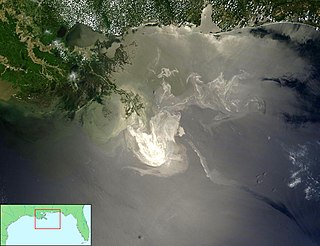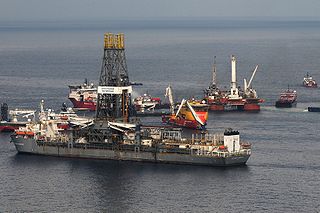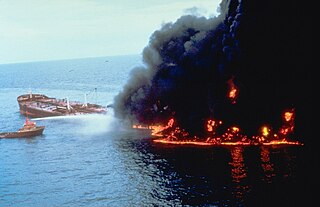
The Exxon Valdez oil spill occurred in Prince William Sound, Alaska, on March 24, 1989, when Exxon Valdez, an oil tanker owned by Exxon Shipping Company that was bound for Long Beach, California struck Prince William Sound's Bligh Reef, 1.5 mi (2.4 km) west of Tatitlek, Alaska at 12:04 a.m. and spilled 10.8 million US gallons (257,000 bbl) of crude oil over the next few days.

An oil spill is the release of a liquid petroleum hydrocarbon into the environment, especially the marine ecosystem, due to human activity, and is a form of pollution. The term is usually given to marine oil spills, where oil is released into the ocean or coastal waters, but spills may also occur on land. Oil spills may be due to releases of crude oil from tankers, offshore platforms, drilling rigs and wells, as well as spills of refined petroleum products and their by-products, heavier fuels used by large ships such as bunker fuel, or the spill of any oily refuse or waste oil.

Mighty Servant 3 is a 27,000-ton semi-submersible heavy lift ship. Its deck is 40 by 140 m. The vessel was built in 1984 by Oshima Shipbuilding Co. Ltd. in Ōshima, Japan, for Dutch shipping firm Wijsmuller Transport, which merged in 1993 with Dock Express Shipping to become Breda-based offshore heavy lifting group Dockwise Shipping B.V.

USCGC Sycamore (WLB-209) is a United States Coast Guard seagoing buoy tender, the second of her name and the ninth of the Juniper-class. She is now home-ported in Newport, Rhode Island, following a one year long Midlife Maintenance Availability (MMA) in Baltimore, Maryland. She was originally home-ported in Cordova, Alaska. Sycamore primarily tends to aids-to-navigation (ATON) in Martha's Vineyard, the Long Island Sound, Hudson River, and New York City Harbor and entrances; however she is also responsible for maintenance support of National Data Buoy Center's offshore weather buoys. In addition to her primary ATON role, Sycamore also performs other duties, such as, marine environmental protection, maritime law enforcement, domestic icebreaking, search and rescue, and homeland security missions.

The Deepwater Horizon oil spill was an industrial disaster that began on 20 April 2010, in the Gulf of Mexico on the BP-operated Macondo Prospect, considered to be the largest marine oil spill in the history of the petroleum industry and estimated to be 8 to 31 percent larger in volume than the previous largest, the Ixtoc I oil spill, also in the Gulf of Mexico. The U.S. federal government estimated the total discharge at 4.9 million barrels. After several failed efforts to contain the flow, the well was declared sealed on 19 September 2010. Reports in early 2012 indicated that the well site was still leaking. The Deepwater Horizon oil spill is regarded as one of the largest environmental disasters in American history.
The following is a timeline of the Deepwater Horizon oil spill. It was a massive oil spill in the Gulf of Mexico, the largest offshore spill in U.S. history. It was a result of the well blowout that began with the Deepwater Horizon drilling rig explosion on April 20, 2010.

Discoverer Enterprise is a fifth generation deepwater double hulled dynamically positioned drillship owned and operated by Transocean Offshore Deepwater Drilling Inc., capable of operating in moderate environments and water depths up to 3,049 m (10,000 ft) using an 18.75 in (47.6 cm), 15,000 psi blowout preventer (BOP), and a 21 in (53 cm) outside diameter (OD) marine riser. From 1998 to 2005 the vessel was Panama-flagged and currently flies the flag of convenience of the Marshall Islands.

Helix Producer I is a ship-shaped monohull floating production and offloading vessel, converted from the ferry MV Karl Carstens. It has no storage capability.
Following is a timeline of the Deepwater Horizon oil spill for June 2010.
Following is a timeline of the Deepwater Horizon oil spill for July 2010.
Following is a Timeline of the Deepwater Horizon oil spill for May 2010.
Reactions to the Deepwater Horizon oil spill from various officials and interested parties ranged from blame and outrage at the damage caused by the spill, to calls for greater accountability on the part of the U.S. government and BP, including new legislation dealing with preventative security and clean-up improvements.
Efforts to stem the Deepwater Horizon oil spill were ongoing from the time that the Deepwater Horizon exploded on 4/20/2010 until the well was sealed by a cap on July 15, 2010. Various species of dolphins and other mammals, birds, and the endangered sea turtles have been killed either directly or indirectly by the oil spill. The Deepwater Horizon spill has surpassed in volume the 1989 Exxon Valdez oil spill as the largest ever to originate in U.S.-controlled waters; it is comparable to the 1979 Ixtoc I oil spill in total volume released.
California Responder is a Responder-class oil-skimming vessel registered in Norfolk, Virginia, USA, and based in Port Hueneme, California. California Responder and her sister ship, Pacific Responder, operated off the coast of Louisiana in the Gulf of Mexico during the Deepwater Horizon oil spill. The vessels sailed to the gulf from their home ports in California to assist in the containment efforts.

Pacific Responder is a Responder-class oil-skimming vessel registered in Norfolk, Virginia and based in San Francisco, California.

The Deepwater Horizon oil spill occurred between April 10 and September 19, 2010 in the Gulf of Mexico. A variety of techniques were used to address fundamental strategies for addressing the spilled oil, which were: to contain oil on the surface, dispersal, and removal. While most of the oil drilled off Louisiana is a lighter crude, the leaking oil was of a heavier blend which contained asphalt-like substances. According to Ed Overton, who heads a federal chemical hazard assessment team for oil spills, this type of oil emulsifies well. Once it becomes emulsified, it no longer evaporates as quickly as regular oil, does not rinse off as easily, cannot be broken down by microbes as easily, and does not burn as well. "That type of mixture essentially removes all the best oil clean-up weapons", Overton said.
Modular Capture Vessels are converted oil tankers which can capture hydrocarbons or other liquid contaminations from leaking oil and gas wells in deep sea areas. MCV's in general operate as normal oil tankers and provide capture and containment services in the event of a potential deepwater well control incident.

The GuLF Study, or Gulf Long-term Follow-up Study, is a five-year research project examining the human-health consequences of the Deepwater Horizon oil spill in April 2010. The spill followed an explosion on a drilling rig leased by BP, the British oil company, and led to the release of over four million barrels of oil into the Gulf of Mexico, 48 miles off the coast of Louisiana in the United States.

The Mega Borg oil spill occurred in the Gulf of Mexico on June 8, 1990, roughly 50 miles off the coast of Texas, when the oil tanker Mega Borg caught on fire and exploded. The cleanup was one of the first practical uses of bioremediation.
Marine Well Containment Company (MWCC) provides well containment equipment and technology in the deepwater U.S. Gulf of Mexico for use after blowouts. It is based in Houston, Texas. MWCC members are major companies in the petroleum industry that drill wells in the Gulf of Mexico including: BP, Shell Oil, ExxonMobil, Chevron Corporation and ConocoPhillips.












